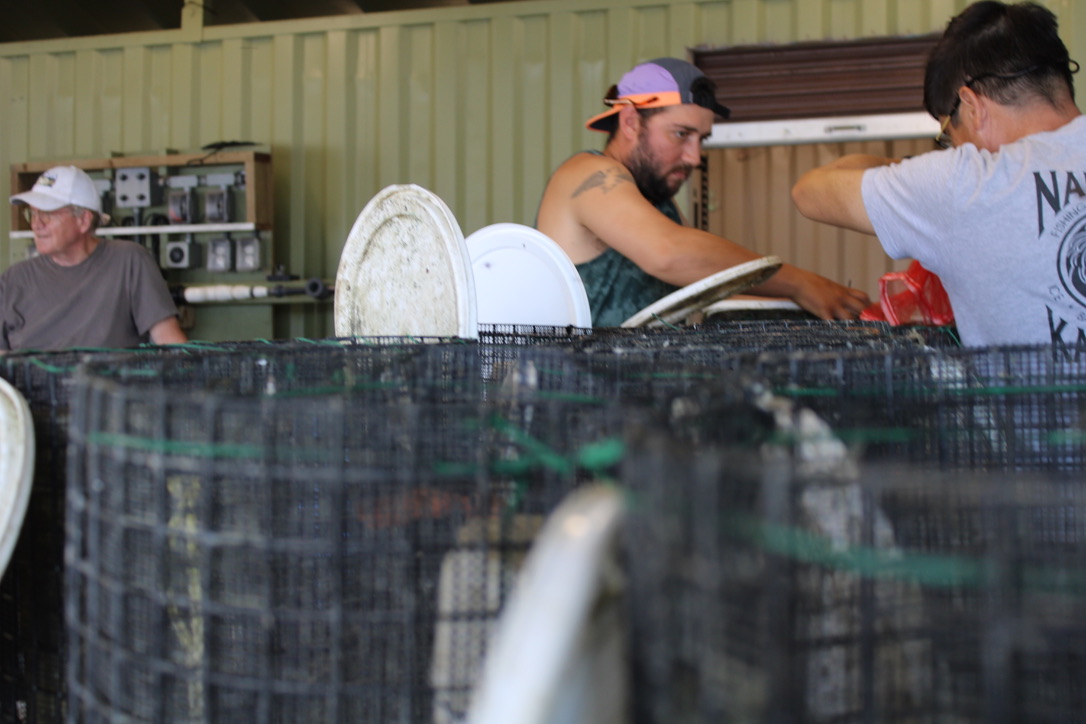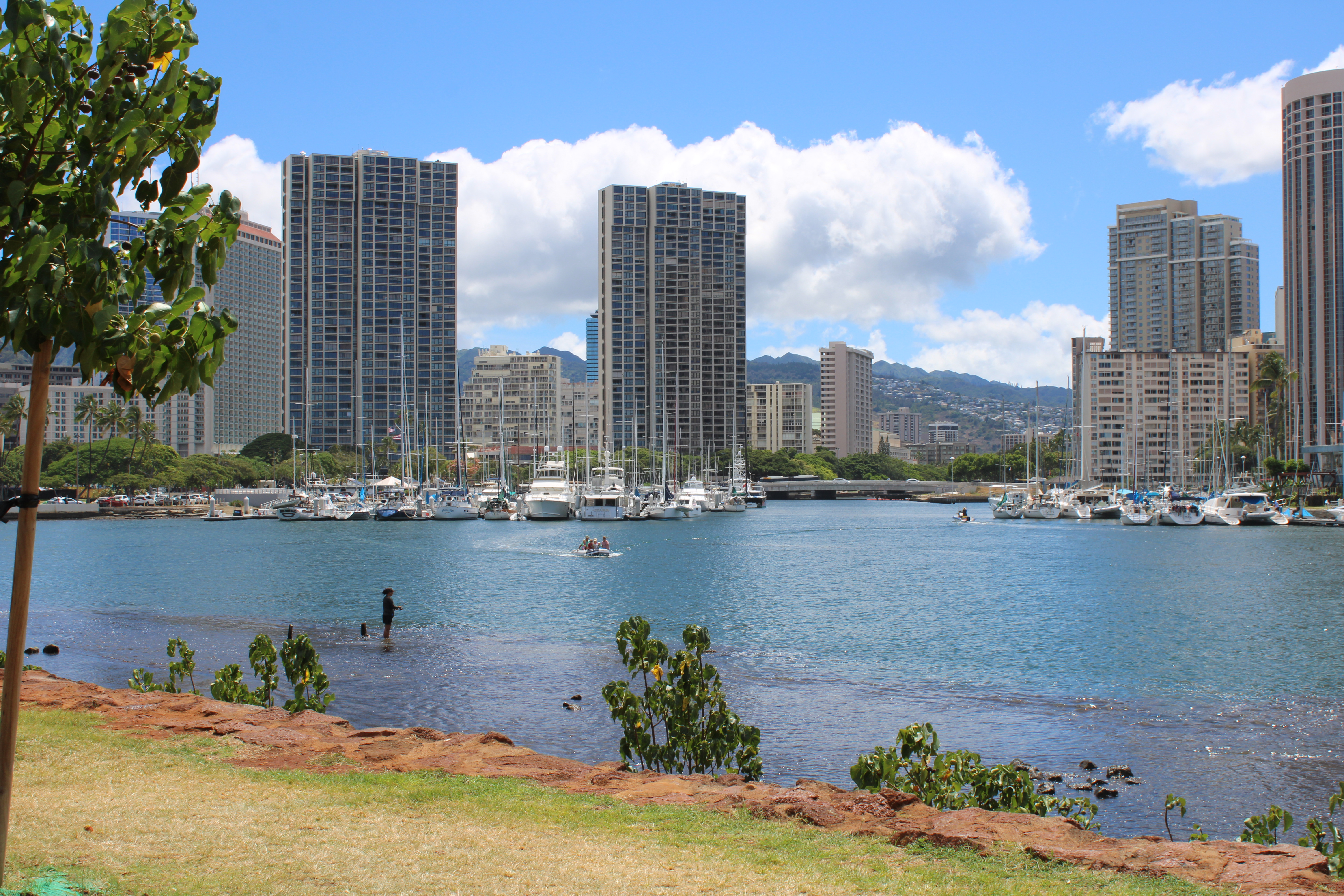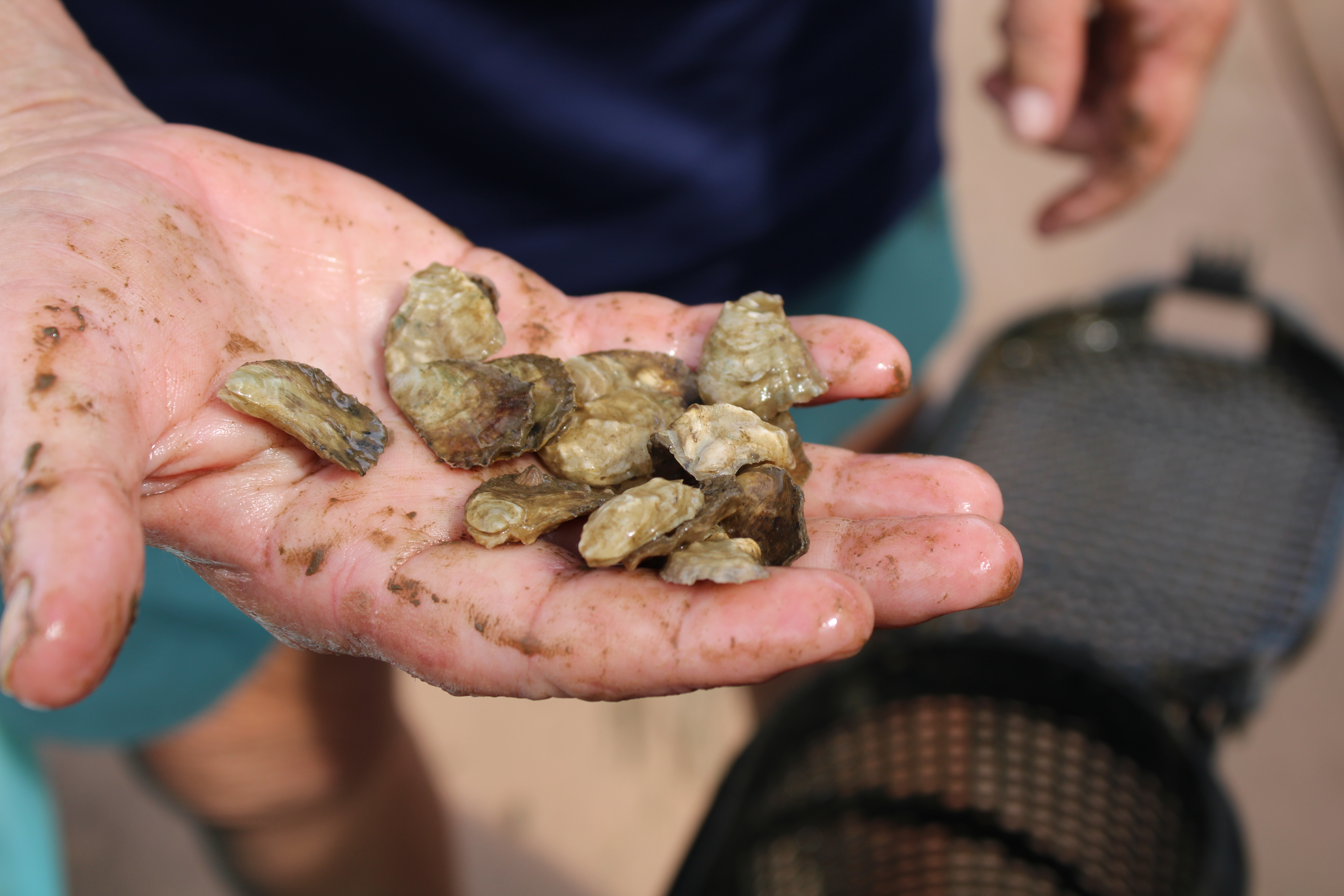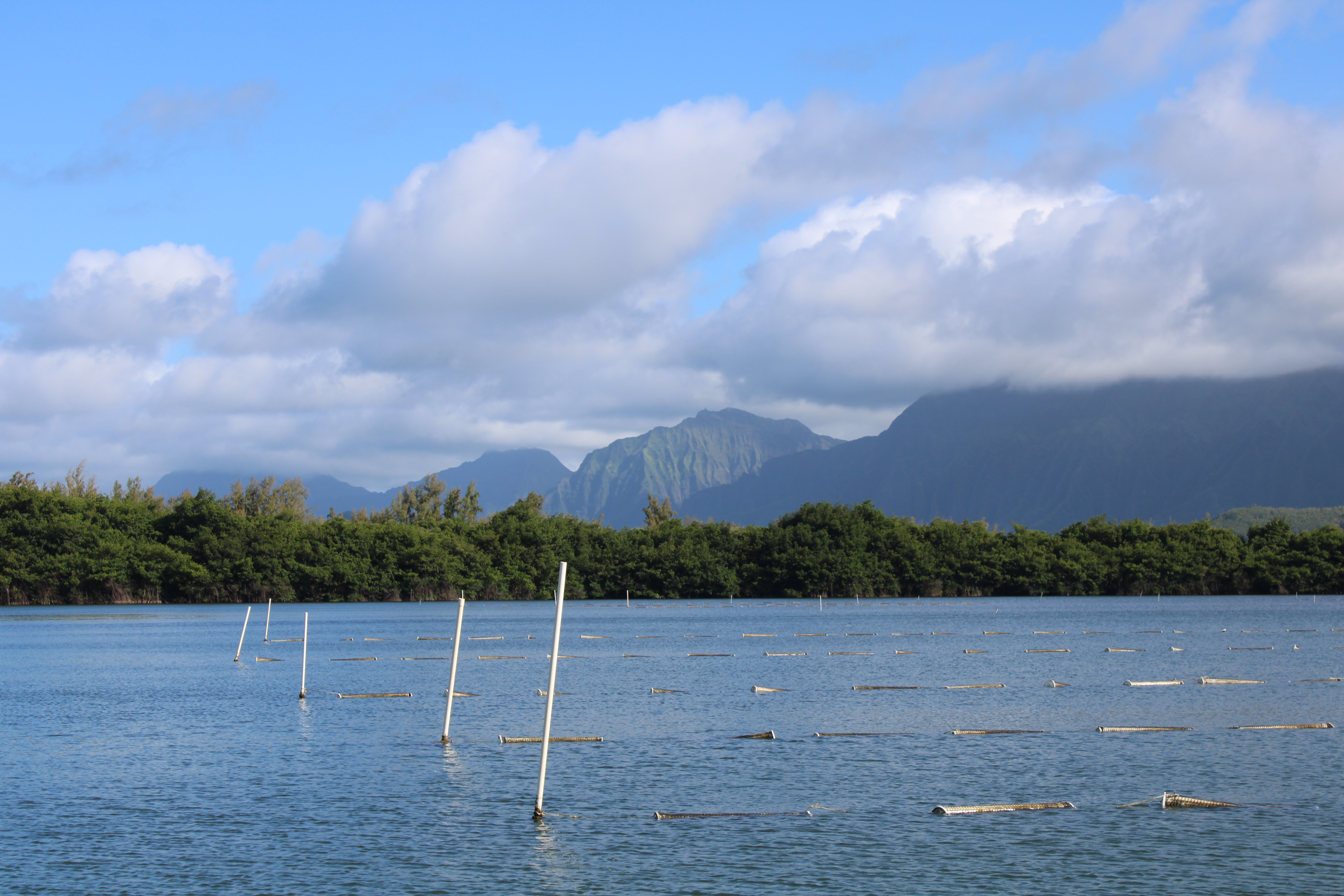More than two decades ago, Walter Ritte was hunting a deer. What followed was a frustrating series of events that led to him becoming a Hawaiian rights activist. Restoring fishponds, or loko iʻa, is a fundamental component of that role.
Fishponds are the oldest form of aquaculture in the Pacific Rim. They are essentially enclosed estuaries; the ancient Hawaiians dry-stacked rocks to form a wall, or kuapā, around the nearshore environment, typically at the point where a freshwater stream flowed into the sea. Some ponds could fit in a backyard, others encompass more than a hundred acres. One of the defining characteristics of loko iʻa are their mākāhā, or sluice gates. The mākāhā ensure that the fishponds require zero inputs.
In their heyday, freshwater coursed from the island into the ponds, bringing nutrients. Seawater flowed into the ponds through the mākāhā bringing seaweeds, limu, and other food for herbivorous fish. Small fish swam into the ponds, grew fat, and eventually were too big to swim back out. The ponds were filled with herbivores such as awa, aholehole, and ʻama ʻama—milkfish, Hawaiian flagtail, and striped mullet.
That is not the case today. When the West colonized the Hawaiian Islands, more than two hundred years ago, it initiated some big changes. Not least among them: the shift from an agrarian economy to a market economy, from communal land to private property, from subsistence farming to plantations, and, eventually, from a monarchy to statehood within a democracy. While the archipelago was in flux, the fishponds wasted away. The knowledge of how to care for them dissipated.
Uncle Walter is one of the first present-day Hawaiian fishpond caretakers. He and his friends removed invasive mangroves, which create anoxic waters that attract parasites. They rebuilt the kuapā, deepened the ponds, and fished out invasive species and predators.
Some of the native fish came back to Uncle Walter’s pond on Molokaʻi. “For us, this is about feeding the people. So right now, we feel it’s successful because it’s feeding our entire family. And hopefully we can feed more and more.”
This restoration process informed and supported other ponds. The prospect of viable fishpond aquaculture has become increasingly popular: the concept of a sustainable, culturally significant aquaculture practice that can make Hawaiʻi less dependent on food imports and diversify its economy is irresistibly appealing. More people were inspired to start working towards that goal. What formed around Uncle Walter was a cohort of fishpond caretakers, and what formed around them was an interconnected web of opinionated and passionate scientists, nonprofit leaders, community members, conservationists, cultural practitioners, aquaculturists, and civil servants. It’s an industry full of characters. They all want what is best for the fishponds and for Hawaiʻi, but how they define “best,” and how they plan to achieve it, differ markedly.
The diversity of their opinions and philosophies is becoming ever more stark as they complete restoration and start envisioning production. Now that it’s time for the fishponds to start producing fish, the fishpond community worries about why they are not.
There aren’t fish in the ponds—at least, the kind that fishponds traditionally kept.
It started with the transition from the traditional Hawaiian ahupuaʻa land management system to the Western system of privatized land. The moku, island, was divided from the mountains to the sea, mauka to makai, into pie-shaped segments called ahupuaʻa. The ahupuaʻa tended to follow the flow of freshwater: clouds poured rain upon the mountains, freshwater flowed through the forests, into the farmland, through the taro fields, and, finally, nutrient-rich, out into the sea where it formed estuarine habitat. It was overseen by a konohiki, someone designated by the ruling nobleman to care for the land.

Workers at Moliʻi Pond fill the mesh cages with oyster spat. (Image credit: Grace Cajski)
When this system was ousted by its Western counterpart, there were no konohiki to ensure that freshwater flowed all the way to the sea. As the islands became more crowded, especially Oʻahu, the population used up the islands’ freshwater. Less and less freshwater flowed to the sea to form estuarine habitat. Streams were diverted. Estuaries dredged (the most prominent example is the hot-spot tourist destination Waikiki, which was once so plentiful that its name means “spouting fresh waters”). Aquifers drained. Ponds these days have the salinity levels of salt water. They aren’t the nutritious nursery grounds that attract fish.
Another problem is invasive species. Among the most dangerous to fishponds are the Australian mullet, the limu gorilla ogo, mangroves, and the toʻau (black snapper).
This problem is exacerbated by their apparent hardiness. As development continued, more pollution and runoff spewed into nearby waters. Native aquatic organisms began to disappear, bringing traditional fisheries, namely the striped mullet fishery, to the brink of depletion. The fishponds can no longer naturally recruit fish.
Waikiki used to be estuarine habitat but is now extremely developed. (Image credit: Grace Cajski)
These compounding issues give rise to one overarching question: when the essential processes that define fishpond aquaculture—that is, freshwater coming down from the mountains and native fish coming in with the sea—are no longer occurring, how will, or can, fishpond aquaculture operate?
There are a host of philosophical and existential questions fishpond caretakers have to ask themselves in order to even begin to contemplate that one essential question. The answer lies somewhere in a balance between tradition and adaptation.
Every fishpond operates with a different philosophy, and every fishpond finds a different balance.
The largest of them is Moliʻi Pond, one hundred and twenty-eight acres in the northern waters of Kāneʻohe Bay. Under the direction of its caretaker Kuʻuipo McCarty, it grows Pacific oysters. Moliʻi Pond is part of the nature retreat Kualoa Ranch, and, a little more than ten years ago, the ranch encouraged the pond to grow more products. Moliʻi Pond started cultivating oysters, and its efforts paved the way for a lot of other fishponds to do the same.
Native oysters growing in tanks at Waikalua Loko, waiting to be transplanted into the pond. (Image credit: Grace Cajski)
Some ponds are addressing the nexus of complex problems by growing different marine organisms than the ancient Hawaiians. The modern environment doesn’t support striped mullet and its counterparts anymore, and they don’t fetch much in the modern economy.
Bivalves are a common choice among producing fishponds. Importing such heavy wares is expensive, so local producers don’t face stiff competition from foreign or interstate companies. And, growing oysters is a form of bioremediation.
Nomilo pond, on Kauai, is looking to expand this model of simultaneous bioremediation and profit. It currently grows limu and bivalves. This coming September, it will start growing sea cucumbers. Sea cucumbers consume detritus, so they help reduce the layer of waste from fish and mangroves. And, they are a popular delicacy.
Some fishpond caretakers, including Walter Ritte, support the idea of a state-run mullet hatchery. This would allow the ponds to acquire pua ʻama ʻama, baby mullet, and stock their ponds with native fish without having to naturally recruit them.
Waikalua Loko is embracing that idea. This pond, nestled in a pocket of southern Kāneʻohe Bay, is eleven acres of salt water. The Kawa Stream, which has historically fed freshwater into the pond, was diverted in 1958 to accommodate development. It now snakes through a golf course. Which is perhaps for the best since it is one of the most degraded streams in the state. The nonprofit Pacific American Foundation (PAF) operates the pond, and after twenty-six years restoring the pond, they are concluding that work with one last project. They are collaborating with the nonprofit Oʻahu Waterkeeper to grow native oysters that improve the pond’s water quality.
In the coming months, Waikalua Loko will work with the University of Hawaii Sea Grant College Program’s aquaculture specialist Dr. Kai Fox to build an IMTA facility that grows hatchery-raised pua ʻama ʻama. Their wastewater will flow to limu, and the water from that tank might flow to some oysters, too.
Moliʻi Pond grows Pacific oysters in floating mesh cages. (Image credit: Grace Cajski)
Some fishponds are still completing the restoration process and are focusing more on education. Loko Ea, a fishpond on the North Shore of Oʻahu, and Heʻeia Pond, in Kāneʻohe Bay, both prioritize cultural heritage and growing native species.
Caretakers for these fishponds, and those of numerous others, meet with other members of the fishpond community at annual gatherings organized by the Hui Mālama Loko Iʻa branch of the nonprofit Kuaʻāina Ulu ʻAuamo (KUA). They discuss these adaptation measures, permitting and poaching, the health of the ahupuaʻa, in addition to traditional practices.
The first fishpond was built nine hundred years ago, and for the past nine hundred years these ponds have withstood eras of great upheaval and have flourished in eras of great abundance. The resourcefulness and diversity of the fishpond community all but promises the resilience and longevity of the loko iʻa. “It is totally possible to have a traditional fishpond operate in a modern setting, economy, and climate,” Keliʻi Kotubetey, the assistant Executive Director of Heʻeia Pond remarked. “But it will require innovation, creativity, and support from all levels and portions of the community.”
—
The research for this story was made possible through the generosity of the Yale Law School's Law, Ethics & Animals (LEAP) Student Grant Program, the Yale Sustainable Food Program’s Global Food Fellowship, the Yale Environmental Humanities Grant, and the Yale CIPE Summer Journalism Fellowship.
This feature appeared in Environment, Coastal & Offshore (ECO) Magazine's 2021 Autumn edition, to read more access the magazine here.








